The Synthetic Musk Market is estimated to be valued at USD 142.6 million in 2025 and is projected to reach USD 221.5 million by 2035, registering a compound annual growth rate (CAGR) of 4.5% over the forecast period.
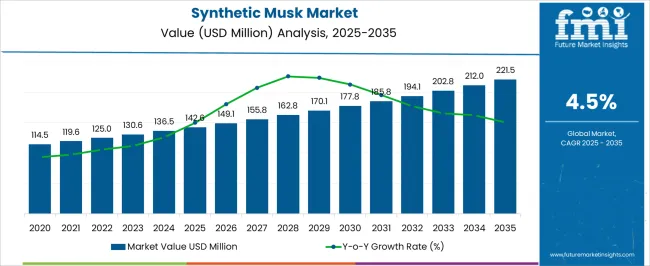
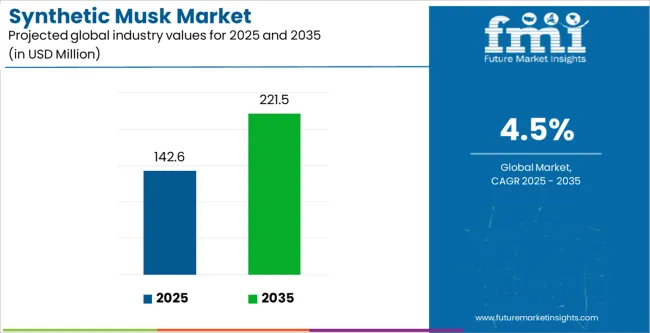
| Metric | Value |
|---|---|
| Synthetic Musk Market Estimated Value in (2025 E) | USD 142.6 million |
| Synthetic Musk Market Forecast Value in (2035 F) | USD 221.5 million |
| Forecast CAGR (2025 to 2035) | 4.5% |
The Synthetic Musk market is experiencing steady growth driven by the increasing demand for sustainable and consistent fragrance ingredients across the global perfume, cosmetic, and personal care industries. In 2025, the market is being shaped by the shift away from natural musk due to ethical and regulatory constraints, which has propelled the adoption of synthetic alternatives that deliver similar olfactory profiles at reduced costs.
The current market scenario reflects rising consumer preference for long-lasting, high-quality fragrances as well as the expansion of premium and mass-market perfume offerings. Growing investments in research and development for novel synthetic musk compounds are enhancing product performance and safety profiles, allowing fragrance formulators to innovate without compromising on sustainability or compliance.
Additionally, the market is being influenced by emerging applications of synthetic musks in body care products and detergents, which broaden end-use opportunities With rising disposable incomes, evolving consumer lifestyles, and increasing awareness about sustainable sourcing, the Synthetic Musk market is expected to maintain steady growth, supported by consistent demand across global fragrance applications and ongoing innovations in synthetic chemistry.
The synthetic musk market is segmented by product type, application, and geographic regions. By product type, synthetic musk market is divided into Galaxolide, Nitro Musk, Ketone Synthetic Musk, Xylene Synthetic Musk, Polycyclic Musk, Tonalide, Celestolide, Phantolide, and Traesolide. In terms of application, synthetic musk market is classified into Perfumes, Colognes, Soaps, Toiletries, Air Freshners, Body-Wash, Laundry Detergents, Fabric Softeners, Lotions, and Hair Products. Regionally, the synthetic musk industry is classified into North America, Latin America, Western Europe, Eastern Europe, Balkan & Baltic Countries, Russia & Belarus, Central Asia, East Asia, South Asia & Pacific, and the Middle East & Africa.
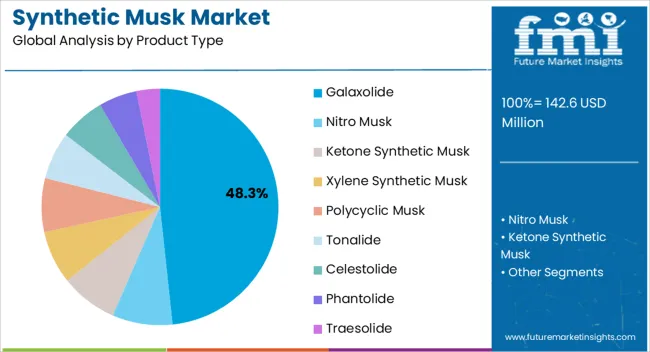
The Galaxolide product type is projected to hold 48.30% of the Synthetic Musk market revenue in 2025, making it the leading product type. This dominance is being attributed to its widespread acceptance due to a well-balanced musky odor, excellent fixative properties, and strong stability across various formulations. Galaxolide is widely adopted in both fine fragrances and household products due to its ability to blend seamlessly with other aromatic compounds while maintaining olfactory consistency.
The growth of this segment has been reinforced by regulatory compliance, safety profiles, and consumer preference for musks that provide long-lasting fragrance without ethical concerns. Additionally, the scalability of production and relatively lower cost compared to natural musk has supported broader market penetration.
Rising demand from both commercial fragrance manufacturers and niche perfumery has further strengthened its position Future growth is expected to be fueled by increasing adoption in multi-component fragrance systems, expanded industrial applications, and continuous improvements in synthesis techniques that enhance environmental sustainability and product performance.
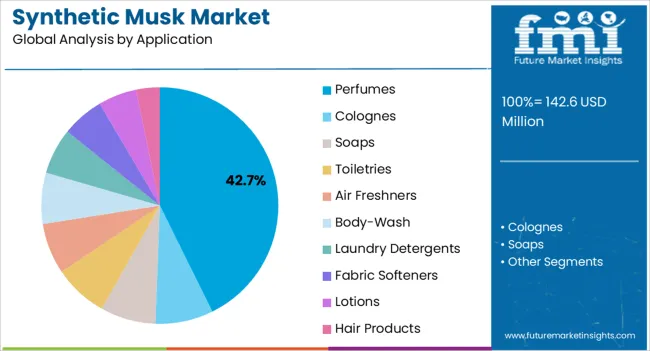
The Perfumes application segment is anticipated to account for 42.70% of the Synthetic Musk market revenue in 2025, establishing it as the leading application area. This dominance is being driven by the consistent requirement for high-quality, long-lasting fragrances in fine and mass-market perfumes. The segment has benefited from increasing consumer awareness and preference for synthetic ingredients that mimic natural musk while addressing ethical and sustainability concerns.
Perfume formulators have widely adopted synthetic musks because they provide stability, intensity, and blendability across diverse fragrance compositions. Rising global demand for premium and personalized perfumes, along with expanding distribution networks in both developed and emerging markets, has reinforced the growth of this segment.
Additionally, the adaptability of synthetic musks to evolving fragrance trends has allowed brands to innovate without relying on scarce or restricted natural ingredients As consumer interest in luxury and niche fragrances continues to rise, the Perfumes segment is expected to maintain leadership, supported by ongoing research in olfactory chemistry and increased penetration of synthetic musk in global fragrance portfolios.
Synthetic musk is a type of aroma compound used predominantly in the perfume industry to imitate the smell of deer musk and musk of other animals such as civet cat, and Louisiana musk rat. The synthetic musk was created to replace the rare and expensive natural musk majorly obtained from the deer. Synthetic musk has been a common content in perfumes; most of the perfumes contain about 10–20% of synthetic musk.
It is used as the base fragrance in many perfumes. However, there are some challenges and regulations pertaining to the use of synthetic musk and their harmful effect on human health. Synthetic musk is used as a flavoring and fragrance agent for numerous applications including cosmetics & personal care, soap & detergent, food, household products, and others. Apart from its use in personal care industry, synthetic musk is also being used for medical purpose.
The extraction of natural musk is a tedious task and there has been ban and regulations on killing of the deer. Moreover, to obtain 1kg of musk grains, ~30 animals had to be sacrificed. Therefore, major producers are switching to the synthetic musk for their need in the perfumery industry.
The production of synthetic musk is regarded as a more ethical and economic way and is being increasingly adapted in the perfume industry. Synthetic musk is also known by alternate name such as white musk.
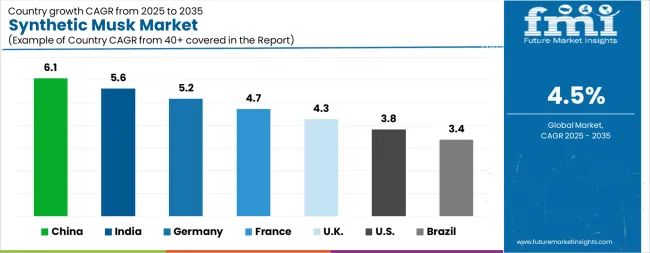
| Country | CAGR |
|---|---|
| China | 6.1% |
| India | 5.6% |
| Germany | 5.2% |
| France | 4.7% |
| UK | 4.3% |
| USA | 3.8% |
| Brazil | 3.4% |
The Synthetic Musk Market is expected to register a CAGR of 4.5% during the forecast period, exhibiting varied country level momentum. China leads with the highest CAGR of 6.1%, followed by India at 5.6%. Developed markets such as Germany, France, and the U.K. continue to expand steadily, while the U.S. is likely to grow at consistent rates. Brazil posts the lowest CAGR at 3.4%, yet still underscores a broadly positive trajectory for the global Synthetic Musk Market. In 2024, Germany held a dominant revenue in the Western Europe market and is expected to grow with a CAGR of 5.2%. The U.S. Synthetic Musk Market is estimated to be valued at USD 52.3 million in 2025 and is anticipated to reach a valuation of USD 76.1 million by 2035. Sales are projected to rise at a CAGR of 3.8% over the forecast period between 2025 and 2035. While Japan and South Korea markets are estimated to be valued at USD 6.8 million and USD 4.1 million respectively in 2025.

| Item | Value |
|---|---|
| Quantitative Units | USD 142.6 Million |
| Product Type | Galaxolide, Nitro Musk, Ketone Synthetic Musk, Xylene Synthetic Musk, Polycyclic Musk, Tonalide, Celestolide, Phantolide, and Traesolide |
| Application | Perfumes, Colognes, Soaps, Toiletries, Air Freshners, Body-Wash, Laundry Detergents, Fabric Softeners, Lotions, and Hair Products |
| Regions Covered | North America, Europe, Asia-Pacific, Latin America, Middle East & Africa |
| Country Covered | United States, Canada, Germany, France, United Kingdom, China, Japan, India, Brazil, South Africa |
| Key Companies Profiled | Givaudan, Firmenich SA, Symrise AG, BASF SE, Eastman Chemical Company, Alpha Aromatics, BMV Fragrances Pvt. Ltd., and Tokos |
The global synthetic musk market is estimated to be valued at USD 142.6 million in 2025.
The market size for the synthetic musk market is projected to reach USD 221.5 million by 2035.
The synthetic musk market is expected to grow at a 4.5% CAGR between 2025 and 2035.
The key product types in synthetic musk market are galaxolide, nitro musk, ketone synthetic musk, xylene synthetic musk, polycyclic musk, tonalide, celestolide, phantolide and traesolide.
In terms of application, perfumes segment to command 42.7% share in the synthetic musk market in 2025.






Our Research Products

The "Full Research Suite" delivers actionable market intel, deep dives on markets or technologies, so clients act faster, cut risk, and unlock growth.

The Leaderboard benchmarks and ranks top vendors, classifying them as Established Leaders, Leading Challengers, or Disruptors & Challengers.

Locates where complements amplify value and substitutes erode it, forecasting net impact by horizon

We deliver granular, decision-grade intel: market sizing, 5-year forecasts, pricing, adoption, usage, revenue, and operational KPIs—plus competitor tracking, regulation, and value chains—across 60 countries broadly.

Spot the shifts before they hit your P&L. We track inflection points, adoption curves, pricing moves, and ecosystem plays to show where demand is heading, why it is changing, and what to do next across high-growth markets and disruptive tech

Real-time reads of user behavior. We track shifting priorities, perceptions of today’s and next-gen services, and provider experience, then pace how fast tech moves from trial to adoption, blending buyer, consumer, and channel inputs with social signals (#WhySwitch, #UX).

Partner with our analyst team to build a custom report designed around your business priorities. From analysing market trends to assessing competitors or crafting bespoke datasets, we tailor insights to your needs.
Supplier Intelligence
Discovery & Profiling
Capacity & Footprint
Performance & Risk
Compliance & Governance
Commercial Readiness
Who Supplies Whom
Scorecards & Shortlists
Playbooks & Docs
Category Intelligence
Definition & Scope
Demand & Use Cases
Cost Drivers
Market Structure
Supply Chain Map
Trade & Policy
Operating Norms
Deliverables
Buyer Intelligence
Account Basics
Spend & Scope
Procurement Model
Vendor Requirements
Terms & Policies
Entry Strategy
Pain Points & Triggers
Outputs
Pricing Analysis
Benchmarks
Trends
Should-Cost
Indexation
Landed Cost
Commercial Terms
Deliverables
Brand Analysis
Positioning & Value Prop
Share & Presence
Customer Evidence
Go-to-Market
Digital & Reputation
Compliance & Trust
KPIs & Gaps
Outputs
Full Research Suite comprises of:
Market outlook & trends analysis
Interviews & case studies
Strategic recommendations
Vendor profiles & capabilities analysis
5-year forecasts
8 regions and 60+ country-level data splits
Market segment data splits
12 months of continuous data updates
DELIVERED AS:
PDF EXCEL ONLINE
Synthetic Dye Market Forecast Outlook 2025 to 2035
Synthetic Data Generation Market Size and Share Forecast Outlook 2025 to 2035
Synthetic Biology Market Size and Share Forecast Outlook 2025 to 2035
Synthetic Abrasives Market Size and Share Forecast Outlook 2025 to 2035
Synthetic Zeolite Y Adsorbent Market Size and Share Forecast Outlook 2025 to 2035
Synthetic Tackifiers Market Size and Share Forecast Outlook 2025 to 2035
Synthetic Spider Silk Proteins Market Analysis - Size, Share, and Forecast Outlook 2025 to 2035
Synthetic Polymer Wax Market Size and Share Forecast Outlook 2025 to 2035
Synthetic Aperture Radar (SAR) Market Size and Share Forecast Outlook 2025 to 2035
Synthetic Diamond Market Size and Share Forecast Outlook 2025 to 2035
Synthetic Turf Market Size and Share Forecast Outlook 2025 to 2035
Synthetic Food Market Size and Share Forecast Outlook 2025 to 2035
Synthetic Polyisoprene Rubber Market Report – Trends & Innovations 2025–2035
Synthetic and Bio Emulsion Polymer Market Size and Share Forecast Outlook 2025 to 2035
Synthetic And Bio Based PMMA Polymethyl Methacrylate Size Market Size and Share Forecast Outlook 2025 to 2035
Synthetic Quartz Market Size and Share Forecast Outlook 2025 to 2035
Synthetic Leather Market Forecast & Growth 2025 to 2035
Synthetic Quartz Industry Analysis in Japan - Size, Share, & Forecast Outlook 2025 to 2035
Synthetic Food Color Market Analysis - Size, Share, and Forecast Outlook 2025 to 2035
Synthetic Paper Market Insights - Growth & Trends Forecast 2025 to 2035

Thank you!
You will receive an email from our Business Development Manager. Please be sure to check your SPAM/JUNK folder too.
Chat With
MaRIA